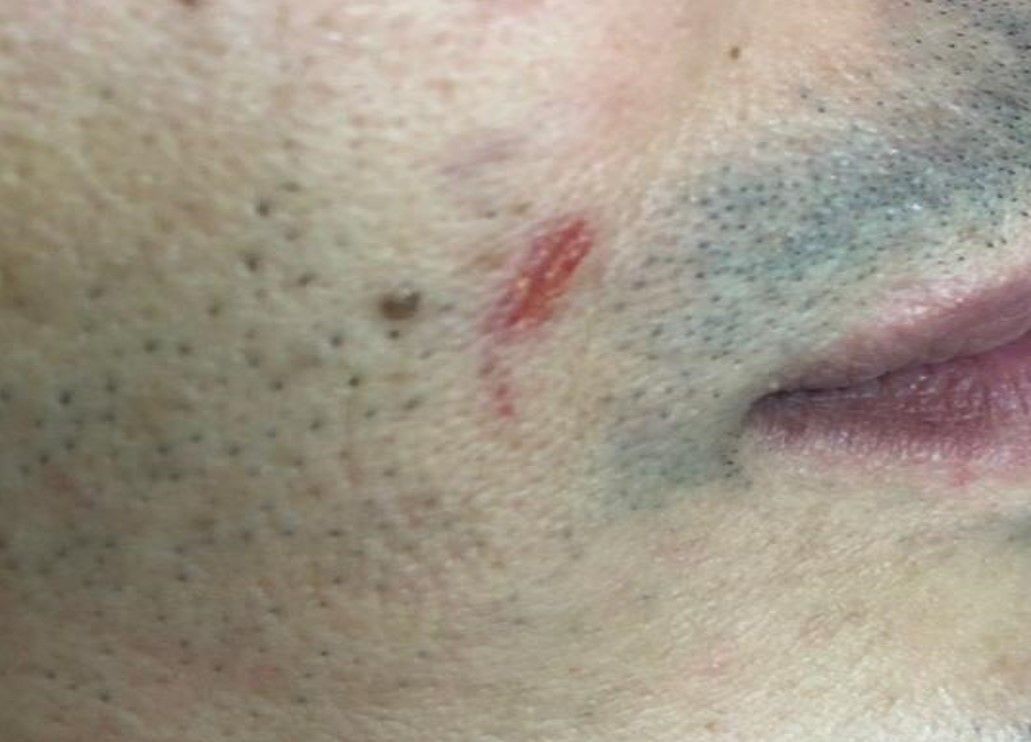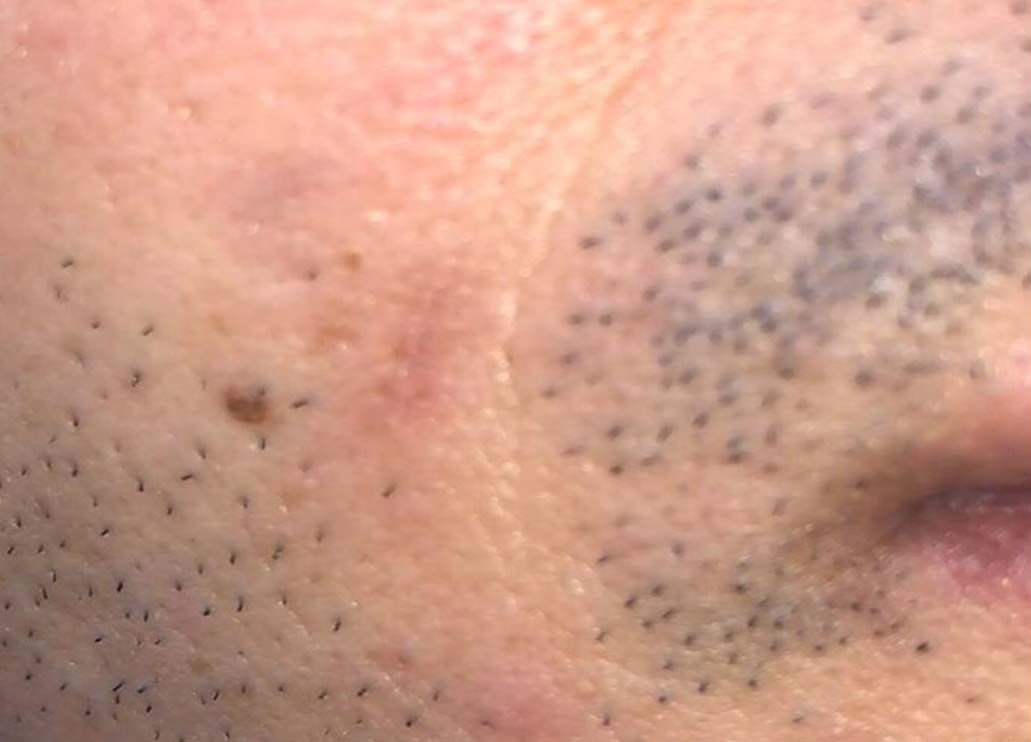- Usage
- Usage Cases
- Cut face
Case №57
Cut face
Odessa city
-
Patient:
Men
-
Age:
40 years old
-
Diagnosis:
Cut face
Abrasions and Scrapes: Treatment, Treatment and Healing Stages
Types of abrasions and scratches
- Stages and stages of abrasion healing
- Stages of healing of abrasions and scratches
- Diseases affecting the rate of healing of scratches and abrasions
- Treatment and treatment of abrasions and scratches
- Features of healing of abrasions on the face
Every person faces abrasions and scratches at least once in their life. They are small, most often non-life-threatening damage to the skin. To avoid infection and ulceration, abrasions and scratches must be properly cared for.
Consider how to quickly cure an abrasion on the face, arm and other parts of the body, what is the first aid for injuries of this kind, what creams are shown for minor damage to the skin.
Types of abrasions and scratches
Taking into account the depth of damage to the surface layer of the skin, abrasions and scratches on the hands, body or face are conventionally classified into two types:
- Small. This includes microtrauma that a person can get through negligence in everyday life. Small scratches are shallow, so they usually heal quickly.
- Deep. They can appear due to careless handling of a knife, broken glass, wood chips, etc. It is important to immediately wash a deep scratch, treat it with an antiseptic to prevent the development of infection. The healing process for deep abrasions and scratches takes 7-10 days on average.
Stages of healing of abrasions and scratches
There is a natural healing mechanism for abrasions and scratches. It starts immediately after an injury has been sustained to close the damage and prevent infection from entering the body.
To shorten the time it takes for complete healing, you need to use the medicines prescribed by your doctor. Modern medicine offers the drug Mirragen, which is unique in its composition and action. It is used as a wound healing agent for severe patients, including those after surgery for wounds and military injuries.
The composition and mechanism of action of Mirragen
Mirragen is a material, not a wound healing or disinfectant liquid. Due to the special structure of its fibers, the action is necessary begins instantly, which is especially important in difficult cases - with chest wounds or for effective wound healing after major operations.Bioactive fibers are extremely small and self-absorbing. In structure, Mirragen resembles a natural fibrin clot that forms in the human body during the normal wound healing process. As a result, a natural matrix is formed in the wound space, which acts as the foundation for natural wound healing and accelerated tissue renewal.
The ability of the material to dissolve is also of clinical importance, since during this process beneficial ions are released into the wound and trauma space, which enhance regeneration at the cellular level. Plus, it eliminates the need to remove material.
When Mirragen matrix enters tissue damaged from penetrating or gunshot wounds, it immediately activates. The matrix interacts with wound fluid, adsorbing pathological secretions. In this case, the appearance of the matrix can change, which is considered absolutely normal.
Wound healing process
As noted above, an abrasion is a slight injury to the skin. Its healing can be described as follows:
- Initial phase. The surface of the abrasion is damp, but gradually dries up. It is located slightly lower than healthy skin.
- The phase of crust formation. It is observed 1-2 days after injury and lasts 2-4 days. At first, the scab is located on the same level with the intact skin, and then it begins to rise above it.
- Phase of epithelialization under the crust. The edges of the scab gradually rise and flake off. After 7-10 days, the crust comes off.
- Phase of the abrasion mark. When the scab falls off, a smooth, pale pink patch remains.It becomes invisible after 10-15 days.
The named terms are average - the process of healing of abrasions can take both faster and longer. It depends on the location and size of the scratch, the addition of the infection, the patient's age, and the presence of other diseases.
Diseases affecting the rate of healing of scratches and abrasions
If first aid for abrasions is provided correctly, healing usually proceeds without complications. But there are situations when a scratch on an arm, face or body does not heal for a long time - it looks inflamed for more than 3-5 days, is painful to the touch, bleeds, a ichor and pus are released from it. Some diseases can lead to such complications:
- eczema;
- psoriasis;
- diabetes mellitus;
- oncology.
It was also noticed that modern remedies, for example, creams that heal wounds and abrasions, do not always have the expected effect if the patient has a low level of hemoglobin in the blood, the immune system is greatly weakened after a previous illness, lack of vitamins and minerals, exhaustion.
Treating and treating abrasions and scrapes on the arm, body or face
The sooner first aid is provided, the lower the risk of microbes entering the wound. Necessary:
- Wash damaged skin with cold boiled water with baby or antibacterial soap.
- Blot the abrasion with a sterile gauze pad.
- Apply wound healing cream to hand, body or face.
- Apply a sterile swab, fix it with a bandage. You can also cover the scratch with a germicidal plaster.
If the wound or scratch does not heal for a long time, it hurts, you need to consult your doctor about taking antibiotics. In some situations, the patient is prescribed laboratory tests to establish the true cause of the slow healing of abrasions on the face, limbs, and trunk.
To speed up the healing of scratches and abrasions, it is important to follow all medical recommendations, timely change the sterile dressing, and reduce physical activity.
Features of healing of abrasions on the face
Not knowing how to quickly cure scratches on the face, some begin to mask the skin defect with the help of cosmetics - powder, foundation, all kinds of correctors. Doctors do not recommend doing this, especially in the first days after injury. The components that make up the cosmetics can slow down the process of skin regeneration, prevent the applied wound-healing creams from acting in full force. It is necessary to wait until the abrasion on the face is covered with a thin scab, and only then resort to tonal foundations.
Cooperate With Us
or via contact phones or email
-
Conveniently
By contacting only one supplier, our customers receive a wide range of products in the shortest possible time.
-
Simple
Our customers are only required to form an order for the supply of products, we will take care of all further tasks
-
Profitable
We save our customers money on import
and delivery taxes


